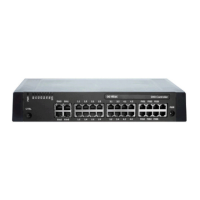234
O
PERATIONS SUPERVISION
CHAPTER 6 OPERATION AND MAINTENANCE
Event tables
Event tables ( =f4) list all the event messages the system is capable of generating (see Event types, in
alphabetical order).
There are 7 event tables. After a first start, all event tables are assigned at least one destination. This
assignment can be modified in the Message destinations ((=h1)) view. Each event table can be config-
ured individually. This means it is possible with a filter to decide which event message – if any – should
be sent to a particular signal destination either immediately, with a delay or not at all.
• No event:
This type of incoming event messages are never sent to the linked destination.
• Every event:
This type of incoming event messages are all sent to the linked destination.
• Custom:
With this setting, you can determine how often the event message may appear for each period, un-
til they are sent to the linked destination.
The Frequency of an event message may range between 2 and 20. The Period is indicated in hours,
ranging between 1 and 672. The longest time period corresponds to 28 days or 4 weeks.
10 E-mail text too
long (body)
User name
authentica-tion
(LOGIN)
11 E-mail
attachment too
large
Password
authentica-tion
(LOGIN)
12 Format of e-mail
attachment not
supported
Authentication
(PLAIN)
13 No e-mail
recipient address
Prepare
encrypted
authentication
(CRAM-MD5)
14 Invalid e-mail
recipient address
Encrypted
authentication
(CRAM-MD5)
15 Invalid e-mail
sender address
Preparing to send
next e-mail
1. Action carried out by the SMTP client at the point when the error occurred.
Table 6.13:Meaning of the parameter values for the event message Send e-mail failed (Continued) (Sheet 2 of 2)

